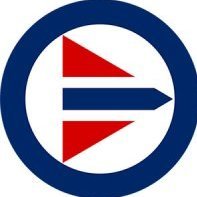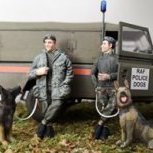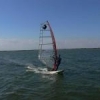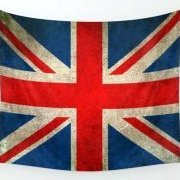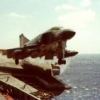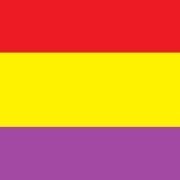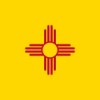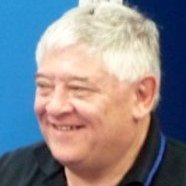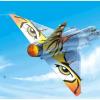Search the Community
Showing results for tags 'NMF'.
-
Non Metallic Metal (NMM) Acrylic Paint Sets Gold & Steel (CS53 & CS54) Lifecolor via The Airbrush Company We’re all familiar with the trials and tribulations of creating realistic metallic shades on our models, coping with the problems of scale effect, the size of particle size for suspension-type metallics, and many more issues that I can’t remember right now. Traditional artists that work on paper and canvas must create their metallics with non-metallic paints, instead creating the highlights, reflections, low-lights and different hues introduced from external sources nearby or from that big angry ball of nuclear fusion that we call the Sun. Some figure painters have taken this technique and attempted to apply it to 3D figures in an effort to create something new and impressive that will solve all the problems associated with the simplistic natural metal finishes that us modellers usually use. Lifecolor have collaborated with talented figure modeller Alessandro Gobbi to create sets of colours that will be useful for modellers to use in creation of their own masterpieces. They are designed to be used in conjunction with white paint from Lifecolor’s own range, which it is assumed that you will already possess if you intend to purchase these interesting sets. You’ll also need to purchase or already own a dose of skill and talent, as the process of creating these shades and shapes on your model will take some time and require you to have an ability with the paint brushes that you’ll use to apply the paint. As this technique may be previously unheard of by many modellers, Lifecolor have taken the trouble to create some helpful guides to assist us with learning the basics of this technique, which you can read by following the links below: NMM Steel (CS54) https://www.astromodel.it/media/fileexchange/cs54_official_guide_compressed.pdf UA 7013 Blinding Moon UA 7014 Riding Sky UA 7015 Thunder Vibe UA 7016 Phantom Blue UA 7017 Ambient Mass UA 7018 Revenge Black NMM Gold (CS53) https://www.astromodel.it/media/fileexchange/cs53_official_guide_compressed.pdf UA 7007 Bright Yellow UA 7008 Ochre Sandstorm UA 7009 Pure Green Light UA 7010 Rebel Brown UA 7011 Dark Code UA 7012 Poison Black Most of us will be aware of the quality of Lifecolor paints in general, and you can have a gander at my original review of their main range here when I was initially introduced to their brand many moons ago, and it’s a review that I have been updating ever since whenever new sets are launched. I thought that these sets were different enough in their intent that they deserved to have a separate review, especially for the PDFs above, for which you’ll need to either have a PDF reader installed, or have a recent browser such as Firefox, Chrome or if you really must, Microsoft Edge, all of which have PDF readers built into their code base, obviating the need for a download from Adobe of the traditional Acrobat Reader of yore. Conclusion It will take some skill and effort to make your work sparkle as well as Mr Gobbi’s work, but it’s an intriguing system that appeals to the dormant artist in me, although any talent I once had has long-since evaporated. If you manage to master the technique, you could just as easily apply it to two-dimensional artwork, should you be so inspired. Highly recommended. NMM Steel (CS54) NMM Gold (CS53) Review sample courtesy of
-
My next build is a kit that I've had for only a year or two, and its one I've done before. When I started college my parents gave me a bunch of Hasagawa Japanese fighter kits for Christmas. the Frank, Jack, Zero, George, Tojo and Tony. I built all but the Tojo and Tony soon after Christmas. That was about the time when I was getting into weathering and starting to use the airbrush again. I wasn't using filler yet, but with these Hasagawa kits, the seams were very good, so that was OK. Even though they aren't up to my current standards, I have never felt the need to replace them. They look pretty good on the shelf and I'm still proud of what I was able to do with my skills at the time. Except the Frank. Don't get me wrong... I did a pretty good job on it, but I new nothing about bare metal finishes back then. So a spray can of silver and zip, zap, painting was done! Now I look at it on the shelf and think, "imagine how that would look if I used what I know now about NMF!" Well, imagine no longer... I bought another copy of the kit so I could do just that, and I plan to strip the old one and do the alternate paint scheme in the instructions. Here's the requisite parts tree shot: It's a simple kit. So what is my plan? First off, after my successful panel line treatment in my last build, I thought I might try it on this kit, since it has raised panel lines. But a test last night on the metal paint I plan to use was a complete bust. Also, scribing the lines is a no-go with my skills. However, with my F-80C and my Oscar I found that leaving the raised panel lines in NMF tricks the eye into thinking they're engraved. A bit of a disappointment after my last build, but I hope the NMF will make everyone forget about the panel lines. Originally, when I got the kit I was going to follow the metal shades on the box artwork since I was having a hard time turning up original photos of the Ki-84. Since then I have found a few photos--especially of the captured US Ki-84 which was bare metal--and found that the panels in the artwork are accurate. Lookng at Japanese types in WWII, I don't see them being very polished, so I will go with a base coat of decanted Tamiya TS-30 Silver leaf, which made an excellent base for my Oscar. The darker panels will probably be Mr. color metal stainless steel and the lighter panels Alclad white aluminum. These are the same paints I used on the Oscar and they looked great together (before they were covered over with IJA green splotches). I started off this morning with the cockpit. A simple affair that will likely not be seen. I looked at my old Frank and the cockpit opening is pretty small and it takes a flashlight to see anything in there. Still, I will probably dress up the seat a bit and fab up some seatbelts. I've taken to building the cockpit before painting if it's a simple enough cockpit (so, I won't be doing this with Eduard spitfires!). I find it's much easier to glue and much easier to paint too. More later...
-
Hi guys! Happy new year to you all! This build is a what if of a french VTOL (Vertical Take-off and Landing) aircraft based on the Tiebflügel 1/35 scale kit from MiniArt. (story in french below 😉 ) After WWII, various allied countries took over a number of German projects. France, with the SNCAT (National Company of Construction of airplanes Thionvilloise😄 ) has taken over and developed the renowned Triebflügel MCT-01 Athos (Triple Centrifugal Modulator) powered by three Fensch 57-02b steerable ramjets studied by Professor Von Boubou (great engine manufacturer of the 1930s, German defector). The aircraft is shown shortly before its first flight in September 1947. The stability being too uncertain, the project was abandoned after 18 flights without accident, however. The French state preferred to continue testing with the more standard propulsion aircrafts from Marcel Dassault. Back to the model, the assembly is very good, the engraving is beautiful. This model was the opportunity to test the Rub'n Buff for the aluminum of the surface. It is one of the best possible effects, but it remains very fragile once placed on the model. I hope you enjoyed this alternative story! Lolo In french: Cette maquette représente un des projets allemand de la 2nde Guerre Mondiale mais, qui n'a jamais dépassé la planche à dessin. MiniArt a donc sorti cette maquette au 1/35 du Focke-Wulf Triebflügel, un avion à décollage vertical. J'ai eu l'idée d'en représenter un what if français. L'histoire aurait été la suivante: Après guerre, différents pays alliées ont récupéré nombre de projets allemands. La France, avec la SNCAT (Société Nationale de Construction d'avions Thionvilloise 😄 ) a repris et développé le Triebflügel renommé MCT-01 Athos (Modulateur Centrifuge Triple) propulsé par trois statoréacteurs orientables Fensch 57-02b étudiés par le professeur Von Boubou (grand motoriste des années 30, transfuge allemand). L'appareil est représenté peu avant son premier vol en septembre 1947. La stabilité étant trop aléatoire, le projet a été abandonné au bout de 18 vols sans accident, tout de même. L'état français a préféré poursuivre les essais avec les appareils à propulsion plus standard de Marcel Dassault.
- 33 replies
-
- 52
-

-

-
- MiniArt 1/35
- Triebflügel
-
(and 1 more)
Tagged with:
-
Hello All, I have been working on this Academy B-29 on and off for a couple of years. Finally decided to make a big push on it to get it done. In any case I have not decided on the markings yet...but most likely a WWII machine. It has a gloss coat of Tamiya black as a base and many hours of polishing before putting on the the Vallejo aluminum...which is outstanding. I have a few panels I will be doing in varying shades but the overall came out pretty good I think. In any case I hope you enjoy the pictures. Of course any comments are greatly appreciated. All the Best! Don
-
Hi all, herewith my second attempt at foiling, hopefully this time armed with as many of the lessons as I can remember from my first attempt! For a bit of background, I obtained 2 freebie Hobby Craft vampire kits (minus instructions and decals) at a recent club meet with the advisory that 'they are not very good kits...'. Well, having never knowingly looked a gift horse in the mouth, I took them anyway to file in the stash under 'Might Come in Useful One Day' . Well lo and behold, having completed my first foil subject, I realised that there were schemes for the Vampire Mk,1 with a NMF - specifically those sold to the Swiss. For a 'larger' scale model it's not overly burdened with detail, to be honest. In my case that's not a bad thing. I could have easily gone overboard on the after-market bling - of which there is a fair bit about - but as previously I was more about the foiling, so I decided to save my pennies for other projects yet to be revealed So, to the build! The office went together fairly easily, and is probably where the lion's share of the detail is to be found: I then assembled the wings and the tail booms. I pinched an idea from a You-Tube clip showing the addition of some cheap-n-cheerful detail in the main wheel wells: I think I have enough to make a start on foiling, so I will hopefully make some progress there soon. Thanks for watching
-
I'd like to show the few pics that I do have of this model. The wind was really gusting the day I took her to the local airport for some pics, and I had to curtail the session early. So, I only have a handful of decent shots. I was glad that I didn’t knock-off either drop tank. I have disengaged them a couple times just moving the model around the display cabinet! 😉 In the very first issue of FineScaleModeller magazine that I ever bought (Jan. ’89), there was an article by the great Bob Steinbrun on converting this old kit into one of the P-80s that were sent to Europe in the waning days of World War Two. Bob did an incredible job on his YP-80 and it sort of inspired me several years later when I built this Korean War-era bird. His bird was finished in grey auto lacquer and really was breathtaking to see. This kit went together well as I recall. Pretty typical of the "good" Monogram models, lot's of detail, very accurate shape and the need for a bit of old-fashioned modeling skill to wrestle it into shape. I recall that the joint between fore and aft fuselage sections needed some work. The model was painted with SnJ aluminum. It came with aluminum polishing powder and the shiniest sections were polished with that powder. I masked some areas to be left unpolished, and some with another shade ( polished without the powder) of the SnJ and some might’ve even been painted with another variety of metal paint. It has been a long time since I built (20 years?) her so some details have probably been forgotten by now. But the now long-gone SnJ was the primary paint used. It was my favorite for NMF by far! I tried to replicate what Mr. Steinbrun did around the gun bay and added a few flourishes, ie. replaced the kit exhaust pipe with a section of ballpoint pen and a few added bits and pieces. Thanks for your interest, and for stopping in to have a look! 😀 So, here’s the “Salty Dog” at the Cameron Airport.
- 17 replies
-
- 31
-

-

-
Just finished this 1/48 Academy P-38 painted to represent Putt Putt Maru flown by Colonel Charles Henry "Mac" MacDonald, who become the third ranking fighter ace in the Pacific during World War II. Built OOB with supplied stock decals, the only real 'issues' were the frustrating 5 piece canopy, the fragile and poorly attached landing gear flaps (had to add some wire supports to keep them attached), and the stock decals are very very thick needing lashings of microsol/set to get them to stick. There are a few seams that I wish I had spent more time on, and are exacerbated by the silver paint I think, but hey ho it is done now Paint is Vallejo Metal Colour aluminium, with their own gloss black primer. It will eventually sit on a base with some suitable ICM and Warriors figures. Photos taken from my phone so apologies for the standard.
-
Hello, I am building these two spits, both NMF (Camouflage has been stripped down) Were the stencils re-applied after paint removal, i.e. should I apply them on my models? Thanks
-
Good afternoon, morning, evening wherever you are in the world! Allow me to present my take on XS927 an English Electric Lightning F.6: This is the now discontinued 1/72 kit from Airfix, built out of the box with the only customisation being some improvements to the cockpit, ejection seat and a stretched sprue pitot. Painted using AK Interactive Xtreme Metal Enamels, primarily polished aluminium. I learnt quite a bit on this one regarding NMF's and using metal repair tape for some even more shiny bits Sealed using AK Interactive Intermediate Gauzy which is a satin/specular varnish designed to go over NMF and then treated to usual oil paint weathering. The kit was quite challenging in places, needed a bit more patience than I anticipated and I think Airfix could have made some better design decisions, particularly when it came to the undercarriage, nose joins and belly seams which took an age to get right and even then, mine are not perfect by any shot. A mostly up to date WIP can be found here: Hope you enjoy, as ever comments, questions always welcome JB
- 35 replies
-
- 60
-

-

-
- EE Lightning
- Airfix 1/72
-
(and 1 more)
Tagged with:
-
Kit – Hasegawa 1:32 (original issue) Paint – Tamiya acrylics & AK Xtreme Metals Decals – Kagero Extras – Barracuda resin wheels, Eduard pre-painted etch seatbelts Republic P-47D-30 Thunderbolt Assigned to Lt. Frank Middleton 65th FS, 57th FG Corsica, mid-1944 An impulse build after the 1:48 Airfix Spitfire from a month or so ago. Five weeks from cracking the box to what you see here – and yes I know I haven’t painted the sway braces on the pylons and centreline yet. As usual with Hasegawa’s BIG kits it simply fell together without any fuss whatsoever, I was expecting ‘issues’ with the multi-piece cowl, but it behaved impeccably. The huge take-away from this build is the incredible quality of AK’s enamel lacquer’s. So much better behaved than Alclad and nowhere near as ‘smelly’. First time using Kagero’s decals and they worked perfectly also. Not much else to say, my first 1:32 completion in a l-o-n-g time and enjoyed so much I dragged-out my H’gawa 109G-14 as a possible next project… Thanks for taking the time to look folks and please feel free to ask any questions or make any comments or criticism. Ian.
- 18 replies
-
- 28
-

-
Given that the Phantom came out in the 1960's and was used as an interceptor by many airforces why do you never see them in natural metal? It's the right era! Is there a metallurgical reason why not, due to oxidation etc, or was it just the case that by the time the Phantom reached service the tactical camo and greys had taken over? If it was left natural were they all silvers or more of a gold / bronze / silver affair like the Streak Eagle F-15? If you have a picture of one in the nude I'd like that...
-
OK, I've been building this for a few weeks now, and taking a few snaps as I go, and I'm making some progress. So I'll try my hand at making a thread here. I didn't want to start too soon, and then crash n burn. Not even sure I can paste pictures on here, but there's only one way to find out...
-
Extras used: Kora Tiger Moth in Spanish service decals and resin wheels, Uschi super fine rigging thread Paints and colours used: Mr hobby Aluminium metalizer What a great little kit, this one marks the start of a little project of mine to have a go at some Spanish civil war subjects. It's a very interesting period (this one is depicted before the hostilities) and the amount of possible aircraft is huge. I found a great website which lists all the aircraft and info etc: http://bioold.science.ku.dk/drnash/model/spain/did.html Anyway onto the pictures, a guy at my local club took these for me, I must say it looks better in pics than in real life! DH. 82a Tiger Moth, Spanish Republican Airforce 1935 Thanks Jason
- 17 replies
-
- 46
-

-
- Tiger moth
- spanish civil war
-
(and 1 more)
Tagged with:
-
Apart from the Eduard PE seat belts, this was built OOB. This was a build of "firsts" for me: first WWII plane, first propeller plane and first build completed in overall silver. It was painted with Polished Aluminium from AK Interactive's new Xtreme Metal range. It went down rather smoothly and had a great shine over a coat of gloss black. However, it did not adhere well to the kit's surface and several parts rubbed off. After spraying the appropriate areas back with the paint, I sealed the whole model with Mr Color gloss clear. This helped protect the paint thoroughly at the expense of the coating losing a bit of the metallic sheen. I elected to keep weathering to a minimum. What little you see was done with oils and pigments. Hope you enjoy the photos! Mark
- 16 replies
-
- 33
-

-
This Airfix Spitfire XIX was built to bring good luck - as Spitfire builds invariably do - to a troubled Vignette GB entry. The decals depicting a Malaya based 81 Squadron PR XIX are from Freightdog. Interestingly, this aircraft was not finished in an Aluminum lacquer, but was bare metal. I've attempted to replicate the finish with brushed on Model Master lacquer metalisers. I saw Ced's Airfix XIX build and Beard's (Simon) silver Airfix F.22 build recently and knew a silver Griffon Spitfire would be just the thing - thanks for the inspiration fellas. Here's a link to the only reference pic I could find online.
- 37 replies
-
- 45
-

-
I have a build to do which has a mix of NMF and white finishes. Unfortunately there is no cheatline, to demark the separations between the white and NMF finishes, so thought I would ask in what order others do their painting. Normally, I would use Tamiya's grey primer base for the whole model; however, the NMF will be in Alclad and using their black as a primer. I think the white would still have the grey primer but not certain on this. My queries are: - is there an order of priming and painting mixes of media? i.e. alclad primer and NMF first, then standard primer and white followed - or vice-versa? - what is the best method for masking/demarking the NMF and white? I'm concerned about bleed/overrun of the two mediums - is there a 'special' way to paint NMF and white mixed liveries on models? I would be very grateful for any helpful advice on this; I've been building and painting models for over 50 years but NMF is a newbie for me. Mike
-
Hello everyone again. After my fourth build since before time began, the Airfix F-51 in NMF ( http://www.britmodeller.com/forums/index.php?/topic/234939145-172-f-51-mustang-fourth-build-since-holiday/#entry1300965 ), I decided to do another NMF with stars and bars, because they're pretty, and I was on a roll with the NMF. So I chose the overly popular 'Triple Zilch' F-100D kit, made mostly straight out of the Italeri box that I got for £5 in a sale. This build very nearly started my own new shelf of doooooooom! Mess up after mess up. Then a general feeling that in no way did the out of kit decals match any image of the Triple Zilch I'd seen any where. Real life interfering a little too much. A 'crash landing' shortly after attaching the under carriage. Who knew how many extra kit bits you can create when that happens?! Loads of little things that drained any enthusiasm out of it and in the end I just wanted it to be finished.. please... stop... Just.. Be.. Finished. But I gritted my teeth and carried on and here it is, the very nearly a shelf of doom kit, 1/72 Italeri F-100D Super Sabre. Additions included: Master Pitot tube: I just love these things. Rob Taurus Vac formed Canopy: I thought I'd give this a try as they're cheap as chips. Not being used to vac form I messed up the front of the canopy but did better on the main. Zillions of these out there, but I still hope you enjoy looking at my meagre efforts once again. 5D2_1736 by IrritableRabbit, on Flickr 5D2_1759 by IrritableRabbit, on Flickr 5D2_1772 by IrritableRabbit, on Flickr 5D2_1765 by IrritableRabbit, on Flickr 5D2_1761 by IrritableRabbit, on Flickr
- 25 replies
-
- 9
-

-
- f-100d
- super sabre
- (and 4 more)


